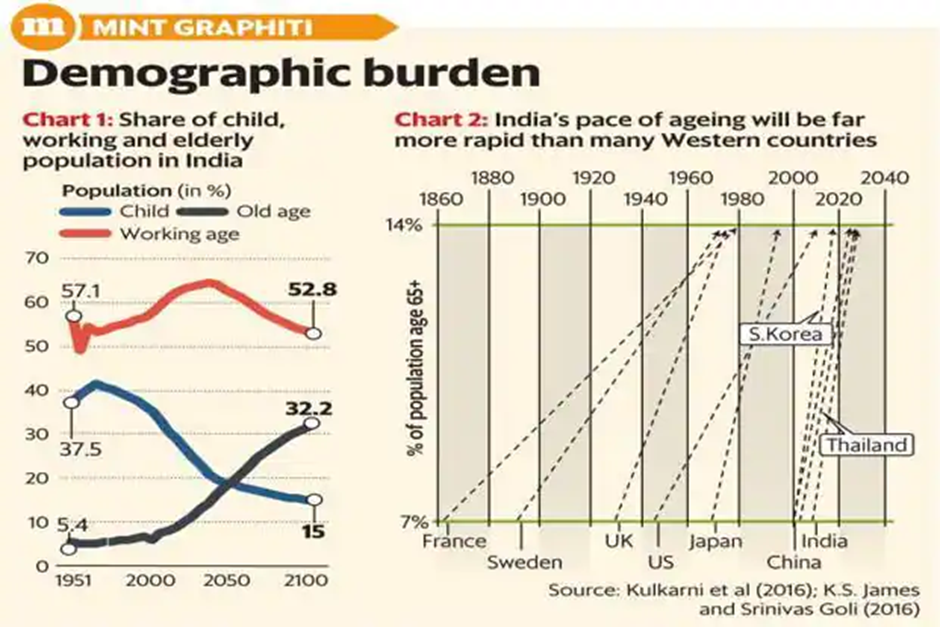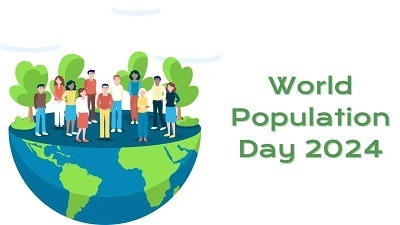Context:
As we observe World Population Day on July 11, there is much to look at in India’s demographic journey over the decades. It was in 1989 that the United Nations established the day after Dr. K.C. Zachariah, a renowned demographer, had proposed the concept of a ‘World Population Day’. The world population had touched five billion in 1987 and challenges such as poverty, health and gender inequality were plaguing the world, developing countries in particular.
The Demographic Landscape: Past Predictions and Present Realities
The 1960s and 1970s were marked by fears of a global population explosion, growing at an annual rate of 2%. Predictions of widespread poverty, hunger, and death were rampant, especially for countries like India. Contrary to these grim forecasts, the subsequent decades witnessed a decline in global fertility rates, improvements in living conditions, and advancements in medical infrastructure, leading to increased life expectancy.
In India, fertility rates began to fall in the 1970s, and today, they are below the replacement level. The country has made remarkable progress in various health parameters, including significant reductions in maternal and child mortality rates.
Sustainable Development Goals and Population Dynamics
In 2015, the UN adopted the Sustainable Development Goals (SDGs), setting 2030 as the target year. India’s progress in achieving these goals is intrinsically linked to its population dynamics, influenced by three main components: fertility, mortality, and migration.
- Fertility: According to the National Family Health Survey (NFHS)-5, India’s total fertility rate (TFR) decreased from 3.4 in 1992 to 2 in 2021, falling below the replacement level of 2.1.
- Mortality: Mortality rates have significantly dropped, and life expectancy has increased, indicating a robust healthcare system and improved living standards. However, India is experiencing a demographic shift towards an ageing population. The proportion of individuals aged 60 and above is projected to rise from 8.6% in 2011 to 19.5% by 2050.
- Migration and Urbanization: Rapid rural-to-urban migration is challenging existing urban infrastructure. Additionally, gender equality remains a critical issue, with low female labour force participation, underrepresentation in politics, and persistent societal challenges.

India's Development Journey and SDG Progress
Ensuring the basic needs of food, shelter, and health for all forms the core of development. India has made significant strides in several areas:
- Population Growth and Fertility Rate: India's population has grown 44% from 100 crore to 144 crore. However, the annual growth rate has fallen sharply from nearly 2% to below 1%, due to the decrease in the total fertility rate (TFR) from 3.4 to 2, just below the replacement level of 2.1.
- Economic Growth and Life Expectancy: The per capita GDP of Indians increased sixfold, from $400 to $2,400. The average lifespan of an Indian rose from 61 years to 70 years.
- Poverty Reduction: The proportion of the population living below the poverty line decreased from 48% in 1990 to 10% in 2019, aided by initiatives like the Mahatma Gandhi National Rural Employment Guarantee Act (MGNREGA) and the Janani Suraksha Yojana.
- Hunger and Nutrition: Despite achieving self-sufficiency in crop production post-Green Revolution, India still faces a severe malnutrition challenge. The POSHAN Abhiyaan launched in 2018 aims to address this issue, though achieving 'Zero Hunger' by 2030 remains a formidable goal.
- Health Improvements: India has seen remarkable improvements in health, with significant declines in maternal and child mortality rates. The Maternal Mortality Rate (MMR) dropped from 384.4 in 2000 to 102.7 in 2020, and the infant mortality rate decreased from 66.7 deaths per 1,000 live births in 2000 to 25.5 in 2021.
What Needs Looking Into?
- Addressing Inequities and Future Challenges : Despite these achievements, the journey towards 2030 is fraught with challenges. Wealth inequality remains stark, with the top 10% of India’s population holding 77% of national wealth. This disparity underscores the need for equitable distribution of development benefits. The Global Hunger Index (2023) ranked India 111 out of 125 countries, highlighting the need for improved nutrition programs. Additionally, India faces a double burden of communicable and non-communicable diseases (NCDs), necessitating stronger healthcare infrastructure and support systems.
- Policy Implications and Gender Equality : To achieve the Sustainable Development Goals (SDGs), India must acknowledge its changing population dynamics in policy formation. Addressing income inequality, creating job opportunities for the youth, and improving healthcare for Non-Communicable Diseases (NCDs) are crucial. Enhanced budgetary allocations for health and nutrition programs are necessary. Gender equality, often overlooked, is pivotal for progress. Empowering women can address multiple developmental issues and accelerate progress towards the SDGs.
- Focus on Welfare Over Population Numbers : In the coming decades, developing nations will prioritise eradicating poverty over responding to population growth alarmists. As Tamil poet C. Subramania Bharati said nearly 100 years ago, "Thani oruvanukku unavillai enil, inda jagatthinai azhithiduvom" (even if one person does not have food to eat, we will destroy the world). Thus, the welfare of the average citizen matters more than macro-level population numbers.
- Expanding Circular Economy : The government emphasised by expanding the Circular Economy framework in the G-20 New Delhi Declaration of September 2023, advocating for decoupling economic growth from environmental degradation while supporting economic growth. It underscores the intent to maintain economic growth in developing nations, termed the Global South, as a priority before achieving net-zero emissions. India aims for zero poverty within the next decade and targets net-zero emissions by 2070, compared to the European Union’s 2050 target.
Conclusion
India's journey from the brink of demographic disaster to striving towards the 2030 SDG targets reflects significant achievements and ongoing challenges. Meeting these targets will require multi-sectoral collaboration and political will. Understanding and addressing population dynamics is crucial for sustainable development, ensuring that progress benefits all sections of society.
|
Probable Questions for UPSC Mains
|
Source: The Hindu







